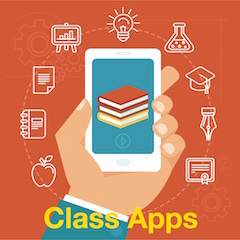Using Google Forms to Reveal Teaching Biases
A MiddleWeb Blog
Hidden biases can affect a teacher’s beliefs about students and impact the way we teach and interact with our learners. Curtis Chandler offers a helpful way to surface them.
I recently overheard a group of students discussing their favorite foods. Most of the items (e.g. Oreos, Funyuns, Fuego Takis, and pizza) came as no surprise.
Their chatter came to an abrupt halt, however, when one kid shared that his “fave” was sushi. He might as well have admitted to eating live tarantulas for all the funny looks and snickers he received.
“You like sushi?” one of his classmates scoffed. “That’s trash!”

The sushi-lover looked sheepish and embarrassed. Other kids started joining in on the tirade, and it wasn’t long before things started to get a bit cruel. That’s when I walked over to the group and interjected, “Are you talking about food? I love snacks and stuff. What are some of your favorites?”
After a little banter, I then asked, “How many of you think sushi is disgusting?” Immediately, nearly every had shot up in the air coupled with a few more disparaging remarks. That’s when said, “Keep your hand up…if you have actually tried sushi yourself.” All but one hand went down.
The young man with his hand still up then admitted that he hadn’t actually tried it himself. Rather, his brother had tried a free sample at a grocery store, got one taste, and spit the whole thing in the trash.
“So…” I pressed. “How can any of us REALLY know if sushi is delicious or disgusting if we have never tried it for ourselves?”
What are you marinating in?
It’s not just sushi that we make misinformed, split-second decisions about. Everything we currently know about neurology, psychology (and a number of other “ologies”) shows that ALL of us have – and act on – implicit bias.
Implicit bias refers to the automatic, unconscious stereotypes that drive each of us – including educators – to behave and make decisions in certain ways (Staats et al. 2015). As one of my colleagues said… “Bias is the marinade of whatever news, conversations, videos, and other influences we are immersed in.”
In the classroom these biases affect teachers’ beliefs about a student’s background, behavior, and potential to achieve. They also impact the way we teach and interact with our learners.
Tracking Your Own Bias in the Classroom
In a recent Edutopia post, psychology professor Maurice J. Elias suggested that educators ask their students and/or a trusted colleague for help in identifying some of the biases we unwittingly slip into our teaching. He suggested we starting by identifying…
► where we tend to face when we teach
► who the teacher tends to call on – male/female, race/ethnicity, disability status
► what part(s) of the room have the students who get called on the most
► which students’ names the teacher uses or does not use when we are called on
Wanting to put this to work in my own practice, I spent a couple of days using Google forms to see if there was a way to put these (and possibly other indicators) to use to create a Teacher Tracker Tool straightforward enough for my students or my colleagues to fill out during class time. The goal is to get some focused feedback about how my own implicit biases tend to play out in the classroom.
If you’re interested in downloading and/or modifying the “Teacher Tracker” form, just click here. For those of you wanting to make your own Teacher Tracker Tool from scratch, click below to see a quick tutorial of the steps I went through.
Whether you are tracking the classroom elements mentioned by Dr. Elias above, or examining another aspect of your interactions, looking at the results/data from the “Teacher Tracker” can be really eye-opening. The key is to look for patterns and trends over time to make conscious adjustments that override our unconscious actions.
Getting to the Root
Each of us should also spend time reflecting upon our own biases…and where they might be coming from. As a starting point, consider answering the six questions below from the book Anti-Bias Education for Young Children and Ourselves:
1. Make a list of all the stereotypes you have heard about the various racial/ethnic groups in the United States. Do this quickly! Don’t censor yourself. Write these down regardless of whether or not you believe them.
2. Examine your list and try to figure out from where or whom you heard those stereotypes, and at what age each came into your life. Be honest with yourself about which ones you believe. You cannot change your thinking unless you first identify what you need or want to change.
3. What kinds of behaviors in boys make you uncomfortable? What kinds of behaviors in girls make you uncomfortable? Where do these two sets overlap, and where are they different? From where or whom did you learn your differing gender expectations?
4. What feelings come up when you work with families with very low income, are homeless, have a family member in jail, or have very high incomes? Do you prefer to teach children from a particular economic class? What or who is the source of your feelings?
5. What feelings come up when you work with families who have parents that are LGBTQ+ gay or lesbian? What messages have you received about such families, or about people who are LGBTQ+ gay or lesbian? What or who is the source of your feelings?
6. What kinds of disabilities do you feel comfortable with? What kinds of disabilities do you feel uncomfortable with? Which kinds of disabilities in children do you find most challenging to work with? What or who is the source of your feelings?
Reflecting on our own biases helps us learn more about ourselves and aids us in the process of identifying and overcoming misinformation that hinders our ability to be more effective in the classroom.
Being Intentional
As educators, we would never deliberately do anything to harm students. Yet too often we unwittingly do (or fail to do) little things that send messages to students that some individuals are more important than others.
Developing habits of self-reflection and a pattern of regular data collection about our classroom interactions helps ensure that our biases don’t go unchecked and that we work to meet the need of all of our students…not just the ones the unreflecting part of our brain tells us to.
References
Derman-Sparks, L., & Edwards, J. O. (2010). Anti-bias education for young children and ourselves (Vol. 254). National Association for the Education of Young Children.
Staats, C., Capatosto, K., Wright, R.A., & Contractor, D. (2015). State of the science: Implicit bias review 2015. Columbus, OH: Kirwan Institute for the Study of Race and Ethnicity.
































